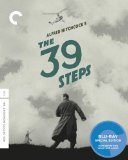| Reviews & Columns |
|
Reviews DVD TV on DVD Blu-ray 4K UHD International DVDs In Theaters Reviews by Studio Video Games Features Collector Series DVDs Easter Egg Database Interviews DVD Talk Radio Feature Articles Columns Anime Talk DVD Savant Horror DVDs The M.O.D. Squad Art House HD Talk Silent DVD
|
DVD Talk Forum |
|
|
| Resources |
|
DVD Price Search Customer Service #'s RCE Info Links |
|
Columns
|
|
|
39 Steps: The Criterion Collection, The
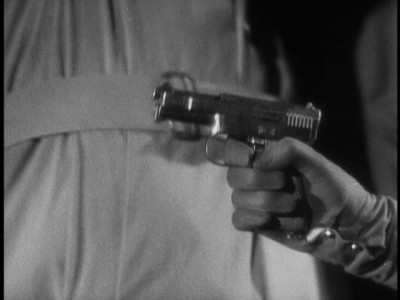
Please Note: The images used here are taken from Criterion's 1999 DVD edition and do not reflect the picture quality of the Blu-ray under review.
In the films of Alfred Hitchcock, the world of seemingly everyday, normal, ordinary experience merely represents the precarious waters lying just outside a powerful whirlpool of danger, intrigue, and sobering (or even deadly/murderous) psychosexual insight that could at any moment pull you into its inexorably spinning depths. As an early case of such a near-drowning, we have the great director's immensely enjoyable The 39 Steps, made in 1935 (during the same British-studio-ensconced initial Hitchcock period that gave us The Lady Vanishes). It was a period during which England was watching very warily the rise of fascism in Europe that would all too shortly force the nation into war; paranoia about enemies and espionage were in the air, and that's what provides this particular Hitchcock number with its specific MacGuffin. But that's really all there is to that; this is certainly no Mrs. Miniver (or even Hitchcock's own later WWII effort for wartime propaganda across the pond, 1942's Saboteur) and wouldn't very accurately be categorized as a war film or even as a spy movie, despite flirting with both of those genres and clearly drawing from a public fear near at hand at the time. The film is more timeless, more abstract, and more elemental than that: It's the story of someone's mistaken identity leading to their realization of the real, disconcerting nature of the people and the world around them, and its style is coolly seductive, drawing us in but holding us at a peculiar distance; thus the only apt genre categorization, the one that best tells you what the picture will be like, is simply "Hitchcock."
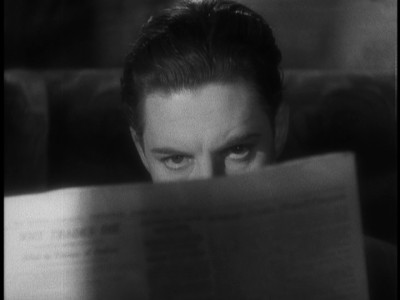
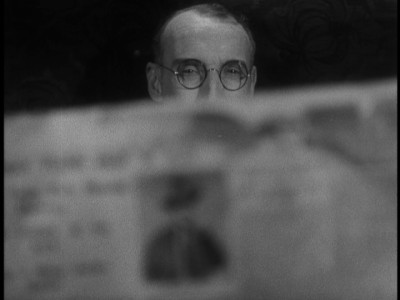
Robert Donat (Goodbye, Mr. Chips) stars as Richard Hannay, the character whose identity gets mistaken and an early avatar of the recognizably Hitchcockian figure that would come to be played by Cary Grant, Henry Fonda, and, definitively, by Jimmy Stewart -- the man just going about his business, whatever his habitual, mundane routine happens to be, perhaps having become a bit too comfortable or cocky in his bachelorhood (it's usually an available man), who has the veil lifted (or the curtain torn, if you'll pardon the pun) to reveal a mercurial, exciting, very dangerous world that shifts at will and may leave him grasping at nothing. Hannay is a dapper Canadian in London who, as the film opens, is buying himself a ticket to a mindlessly fun, lowbrow English music-hall variety show. With a sudden gunshot (beautifully bursting into the montage, an ultra-tight close-up of a disembodied gun that slices, imagistically and sonically, through the raucous music hall scene as a split-second, near-subliminal cut-in), Hannay's life goes from evidently quite uninteresting (we never learn what he's doing in England or much at all about his life outside the film, other than that he was in the Mounties and he's visiting for a couple of months) to swimming in jeopardy: It is in the post-gunfire mad stampede to the exits that he bumps into a woman with German accent (Lucie Mannheim), who, once they're in the clear, invites herself home with him, but not for the reasons Hannay had hoped. Instead, she gives him the obvious pseudonym "Anabella Smith," confesses to having been wrapped up in the firearm episode at the theatre, and tells him she has to hide out because she's in great danger, claiming she's being pursued because she's a counterintelligence mercenary on a mission to prevent some sensitive military secrets from leaving the country and falling into enemy hands. The bemused Hannay doesn't believe such a dramatic, preposterous story, at least not until the woman is killed in the night while taking shelter at his flat, leaving him as the only one alive with the cryptic information and instructions she's given him (a map to a tiny Scottish village no-one's ever heard of, something about "the 39 steps") and a murder suspect, pursued both by Scotland Yard for Ms. Smith's murder and by her actual murderers, who want to stop him from completing her task of thwarting enemy espionage.
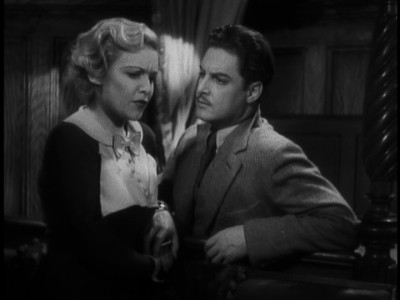
So, at the behest of the urgent, mysterious words of a dying spy, Hannay finds himself pursued into the moors and hills of rural Scotland (a chase that makes for some very striking man-alone compositions) by the police and the villains, ever prey to the watchful eyes of a citizenry that's now had the chance to see his picture in the paper accompanying a lurid tale of a young woman murdered in a London flat. Virtually nobody in Hannay's twisted, tortuous, sleepless path toward some purpose or destination whose nature remains unknown to him is what they appear to be, nor can they be confided or trusted in, least of all a young female fellow-traveler, Pamela (Madeleine Carroll), aboard a train he's hopped, whose compartment he bursts into, the police on his heels, and kisses as a desperate ruse, only to be left hanging when this prim miss promptly turns him in. That won't be the last time that Pamela's assertive credulity, like that of Hannay himself in the face of Ms. Smith's incredible story, will put him in danger; paradoxically, it also pulls her closer in to the web that now surrounds Hannay, eventually much closer than she would prefer (though his charms become more and more clear to her despite herself). Will Pamela be convinced of the veracity of Hannay's story in time to save both their lives from the obscure, murderous group that killed Ms. Smith? What is the 39 steps, and who is the master of disguises with the missing small fingertip the late spy warned Hannay about? And what might the significance be of the tune that Hannay finds himself constantly whistling, though he can't quite place where he picked it up, or of the vaudeville act "Mr. Memory," a human encyclopedia with a sponge-like brain whose act was the one perhaps not coincidentally interrupted by the gunshot that started it all?
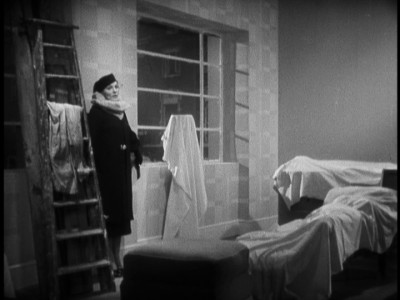
The way that gunshot occurs, as mentioned, is a cinematically bravura moment, and it's only one of a generous handful of very legible Hitchcockian signatures that occur throughout the film (inscribed through the lighting and lens work of cameraman Bernard Knowles, who later shot the lesser-known but wonderful English Gaslight): There's also an elaborate, irreverent, mordantly funny machination involving a pious but treacherous Scottish villager, his wife, and the hymnal he keeps in his coat's breast pocket. Or you have the clever commentary of the opening sequence, in which a disembodied voice and hand we don't yet recognize as Hannay's purchases and receives his ticket to the show, replicating the action any initial viewer of the film would themselves have taken a short time before seeing it replicated onscreen. That's another way in which Hannay is a precursor to Jimmy Stewart, in this example the Stewart of Rear Window: he's our stand-in voyeur, the spectator-within-the-film who's in for a much more involved, implicated experience than he bargained for once he loses his cloaked, safe status as an audience member and gets drawn by force into the action to become part of the show. Whether one is the observed or the one doing the observing is, as always in Hitchcock even going back to some of his silents (and, of course, saturating the later masterpieces), a question that hovers and permeates: When the doomed Ms. Smith enters Hannay's furnished but barely-used, darkened, cavernous flat with its huge, uncovered windows, it's as if she's stepped onto a stage where to be seen (by the pursuers lurking on the sidewalk outside) will mean the end of her. This reverberates all the way through to the climax, where another stage is, in a beautiful composition, the site of the end of the line for another, much less sympathetic character. As always in Hitchcock, the apparent (and always dashingly entertaining) leanness, action, and well-oiled mechanisms of the proceedings contain a parallel dynamic in which unspoken, unconscious desires and fears play out, with the master's style elegantly, seamlessly containing all the film's dimensions and giving them to us all at the same time, beautifully integrated in one elegant, confident, eminently skilled stroke, a feat pulled of without ever breaking a sweat or revealing his hand.
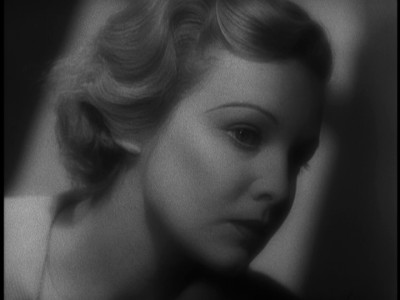
If the relatively snappy pace and comic-romantic vigor of The 39 Steps (and Hitchcock's British films in general) preclude the ironical, tragic grandeur of his later, greater pictures, the early signs of the auteur's sensibility and temperament are here, pointing the way to his future towering stature. One of the most telltale of these signs is in the film's "happy" ending: In yet another virtuoso demonstration of how very well he controls framing, mise-en-scène, and movement for maximum evocativeness, Hitch ends the film fairly close-in on a death from which the camera then pulls back, revealing the finally-clasped hands of Hannay and Pamela. The combined aesthetic beauty and swift narrative economy of this is pure Hitchcock, and so is the troubling note it strikes for such an apparently all's-well ending. A handcuff still dangles from Hannway's wrist, encumbering the entwining of hands and reminding us of all the random, unjust persecution he's been subjected to, and the scene is composed in such a way that the reassuring or enticing fact that the conjoined hands in the foreground belong to two probable future lovers is bound up with the scene's other fact, that they're standing over a fresh corpse. Not for the last time in Hitchcock's incomparably rich filmography, desire/love/romance and danger/death play off of and rely upon each other for their meaning, in this case right inside of the same resonant image. Romance and danger, love and death: you can't have one without the other, not in the world as framed by Hitchcock, and you can never be entirely certain which you'll get.
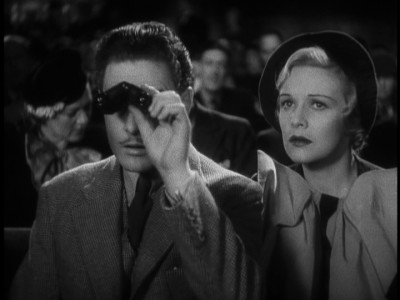
THE BLU-RAY DISC:
The 39 Steps already had quite a decent transfer even on Criterion's old DVD, and they've now one-upped themselves with this new Blu-ray edition (AVC encoded/1080p mastered at the original 1.33:1 theatrical aspect ratio), which looks fantastic. There is an innate softness and some flicker to the materials, and a few signs here and there (stray, tiny scratches, some debris) to indicate that the print we're watching is quite old, but it is overall a fine, extremely careful presentation of some remarkably well-preserved/restored source materials; the contrasts in the film's evocative black and white compositions are sharp as can be, and no indiscriminate indulgence in DNR mars the lovely celluloid texture, experienced here in close to full glory.
Sound:As with The Lady Vanishes, the other early/British Hitchcock recently released to Blu by Criterion, the audio quality of the uncompressed PCM 1.0 monaural soundtrack reflects a certain muffled thinness to the sound that most likely reflects the limitations of making films in England in the '30s (still in the early talkie era and at a remove from the latest technological innovations in synch recording), not any flaw in the audio authoring processes. This not a deal-breaking or overly distracting problem; at worst, you'll find yourself adjusting the volume between softer dialogue scenes and those with louder vocalizations and/or music.
Extras:The supplements here are mostly grandfathered in from the decade-old Criterion DVD of 39 Steps. Changes include a newer documentary on Hitchcock's early British period in place of the archival Janus Films classroom film on the subject included on the DVD, and a switch from the original Marian Keane liner notes to a freshly designed booklet containing a lengthier essay by Scottish critic/filmmaker David Cairns that offers another angle on the primarily Scotland-set The 39 Steps (liner notes by Keane may have been redundant after her in-depth, scene-by-scene exegesis/analysis on her fine audio commentary).
--A brand-new supplement created exclusively for the Blu-ray release, "Borders of the Possible" (24 min.), is a video essay by scholar Leonard Leff, who traces the film's adaptation from the adventure novel by John Buchan, hypothesizes the film's classical (i.e., Greek) attributes, and goes into some very interesting detail explicating Hitchcock's narrative and visual styles as well as his way with actors and characterization, both in general and specifically as manifest in The 39 Steps.
--Hitchcock scholar Marian Keane's full-length audio commentary remains a fine example of a close, detailed reading of the film scene-by-scene, drawing in details of the film's making and Hitchcock's general thematics and approaches as relevant, but focusing primarily on what's there on the screen before us, which is an inspiration and of great interest to anyone interested in serious film appreciation/criticism.
--That newer documentary replacing the old Janus Films one is "Hitchcock: The Early Years (2000, 25 min.), a succinct but thorough rundown of the period preceding Hitchcock's migration to the States and the Hollywood auspices of David O. Selznick. The film goes through Hitchcock's early life and his apprenticeship in the very early British film industry before going on to highlight successes like The Lodger and the original The Man Who Knew Too Much (for which he recruited Peter Lorre from some strange German film called M). Along the way, scholars, experts, and even a few of Hitchcock's now-aged colleagues from those earlier days recount his artistic and personal proclivities (some superstition apparently had him toss his cup over his shoulder after tea), as well as the sour note hit with his very last British film, Jamaica Inn, marked by a contest of wills between Hitchcock and star Charles Laughton (according to opinions expressed here, Laughton won and the film lost).
--A 40-minute interview with Hitchcock extracted/reconstructed from a 1966 episode of the UK TV series Cinema, in which the master himself gives his own detailed recollections in response to the interviewer's questions about his early career. For the entire time, the camera barely moves in its tight close-up on Hitch; just his presence, and that deadly precise, cooly controlled passion for cinema he had like nobody else is enough to keep you riveted from beginning to end.
--An interactive gallery of design sketches by art director O. Wendorff, who art-directed several Hitchcock films, in which his sketches are intermingled with stills of the scenes as they were eventually realized on film, offering a visual step-by-step of yet another part of the filmmaking process for which Hitchcock could never be too well-prepared.
--The excerpts from Hitchcock's famous 1962 interview with François Truffaut where the old master and his young venerator from the French New Wave discuss The 39 Steps in particular.
--Lux Radio Theatre Presents: The 39 Steps, a radio-play version of the story broadcast in 1937, hosted by Cecil B. DeMille and starring Robert Montgomery and Ida Lupino in the roles played by Robert Donart and Madeleine Carroll in the film.
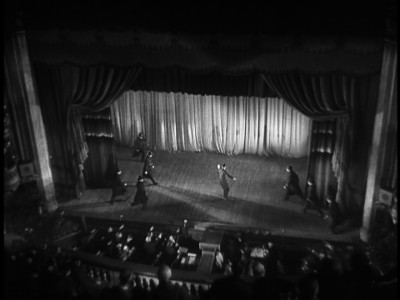
The 39 Steps, like Hitchcock's other earlier efforts from his British period, is longer on charm and shorter on geometrical, cool modernist incisiveness than his later, immortal American masterworks, but it's brilliant already -- tight, tense, wholly devoid of sentimentality. In its story of an ordinary man who's suddenly pulled into an adventure that reveals the sinister, dangerous, mad realities lying just outside (and, if you look closely enough, always glimmering through) the illusions of normal routine, it anticipates everything from The Wrong Man to North by Northwest to Psycho; its device of a musical cue that takes on the eerie, uncanny significance it would in a dream (or nightmare) would later be polished to sparkling in Shadow of a Doubt. But it is just its milder, pleasanter, more conventional pleasures that are the icing on the spicy Hitchcock cake; they're a strong part of what makes The 39 Steps essential for any serious movie lover/Hitchcock aficionado and a joy for even the most casual viewer just looking for a fun, well-crafted entertainment; they lend it an odd, distinctive flavor not quite like any other Hitchcock. Even if The 39 Steps' relative warmth is only the consequence of the master chef not yet having perfected the implacably cool recipe later done to surpassing perfection in Vertigo, et. al., all the ingredients are still combined with the touch and flair of a uniquely inspired cinéaste into a dish whose sweetness blends so well with its substantiveness (and that lingering hint of poison) that you can no longer distinguish between them. Highly Recommended.
|
| Popular Reviews |
| Sponsored Links |
|
|
| Sponsored Links |
|
|
| Release List | Reviews | Shop | Newsletter | Forum | DVD Giveaways | Blu-Ray | Advertise |
|
Copyright 2024 DVDTalk.com All Rights Reserved. Legal Info, Privacy Policy, Terms of Use,
Manage Preferences,
Your Privacy Choices | |||||||









